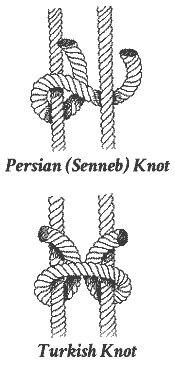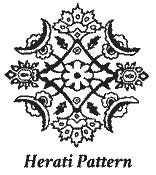The Story of Rugs
Weaving a Beautiful Spell
High-quality rugs can be found in almost any price range. And nothing can improve the way a room looks as quickly. But there are imitations out there, so RugStudio created this quick course in the rugs of the world, with tips you should keep in mind. And we hope you'll keep this in mind as well: no one knows more about rugs than we do. And no one has a better selection than RugStudio.
It is impossible to say exactly when the art of rug making began. Unlike sculptures, pottery and other artifacts, rugs are made of perishable materials. But we do have pictorial evidence of the weaver's art going back at least 3,000 years.
The techniques have changed very little in all this time. Weavers still use wool as the primary material, although silk is common in Chinese rugs. And the process still involves a skilled weaver sitting at a loom, knotting the rug by hand.
 Two types of knots are traditionally used in weaving. The single Senneh knot is generally found in eastern rug weaving countries, while the double Ghiordes knot is used in western regions. Either style allows weavers to create the intricate patterns that give oriental rugs their beauty and exceptional durability.
Two types of knots are traditionally used in weaving. The single Senneh knot is generally found in eastern rug weaving countries, while the double Ghiordes knot is used in western regions. Either style allows weavers to create the intricate patterns that give oriental rugs their beauty and exceptional durability.
It takes just 2 seconds for a skilled weaver to tie each knot. But even at this pace, it can take days to weave a single rug, as row after row of knots are tied, pounded into place, and trimmed.
Today, many rugs are made by machine or by hand-tufting. When made of high-quality materials, they look and feel very much like hand-knotted rugs. The main benefit is that they are more affordable.
Over the centuries, each rug weaving area has developed motifs that are typical of the people of that region.
 For example, the Herati, a small round rosette surrounded by feathery leaves, probably originated in the town of Herat in northwest Afghanistan. It symbolizes the small fish that come to swim in the moon's reflection. The paisley design often found in neckties originated in Persia as the Boteh design. Some think the boteh came to Persia from the ancient Egyptian symbol for wheat, which symbolized immortality.
For example, the Herati, a small round rosette surrounded by feathery leaves, probably originated in the town of Herat in northwest Afghanistan. It symbolizes the small fish that come to swim in the moon's reflection. The paisley design often found in neckties originated in Persia as the Boteh design. Some think the boteh came to Persia from the ancient Egyptian symbol for wheat, which symbolized immortality.
Likewise, regions come to be associated with certain color schemes, like the sky-blue color found in the rugs of Qum which is said to be inspired by the blue rooftops of the holy city.
Rugs have served many purposes over the centuries, from the mundane to the religious. But that is part of their magic -- that this one art form can serve so many purposes. Perhaps that is why they have cast so strong a spell over people.